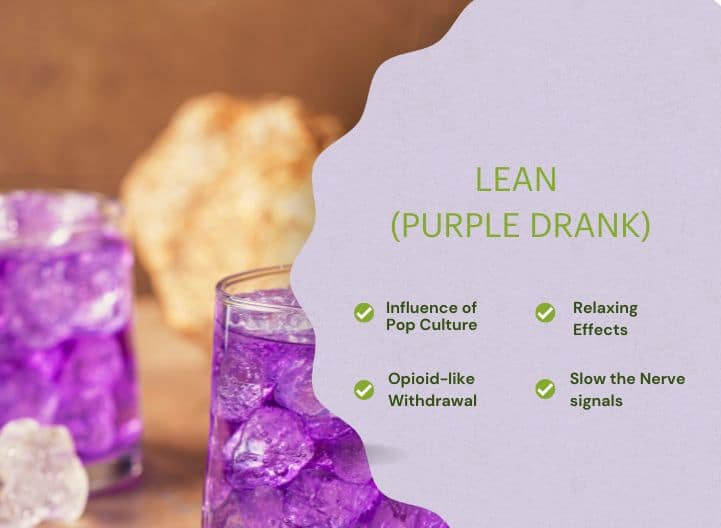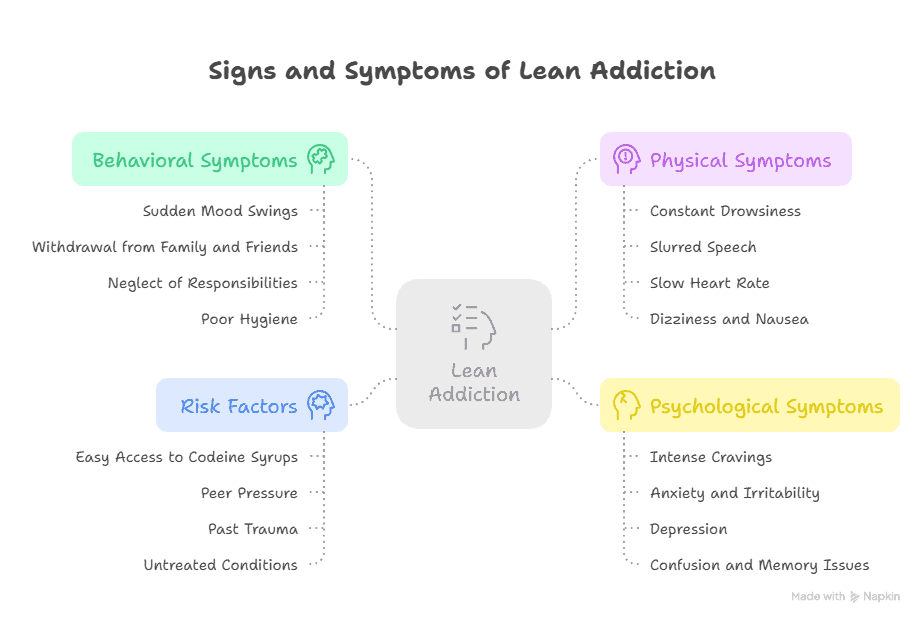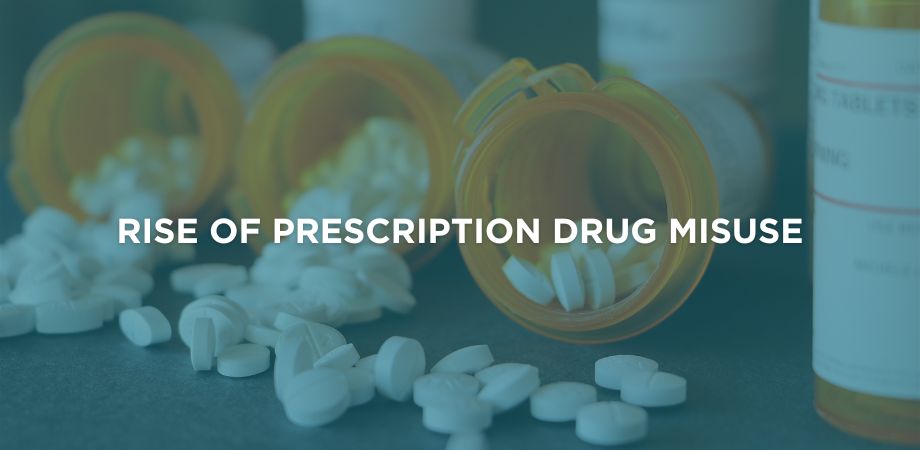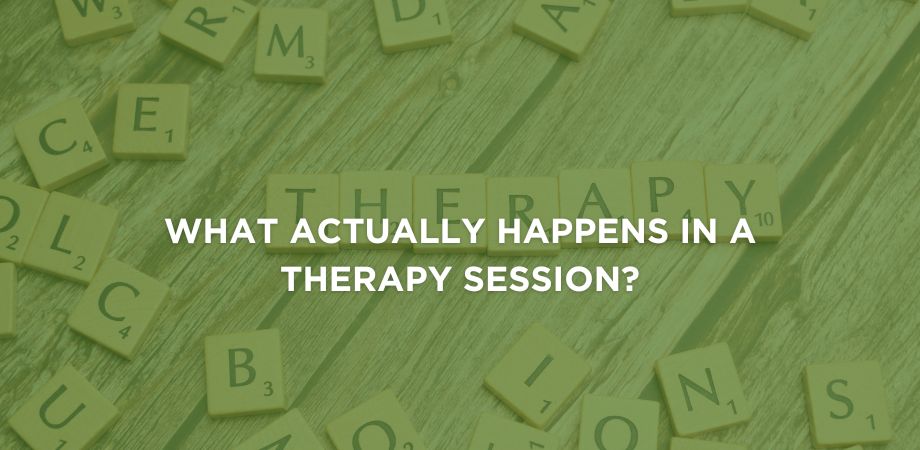Lean, often known as Purple Drank or Sizzurp, is a drink made by mixing prescription-strength cough syrup that contains codeine and promethazine with soft drinks and sometimes candy. The combination produces a strong sedative effect that appeals to many young users.
Its rise in popularity comes largely from rap culture and social media, especially in the United States, where celebrities have portrayed it as glamorous and fashionable. This trend has influenced teenagers and young adults in different parts of the world, including India.
Behind the colorful image lies a harsh reality. Lean is addictive and carries serious health risks such as organ damage, dependence, and overdose. This article examines the dangers linked to Lean use and explains effective treatment options that can help individuals and families move toward recovery.
What is Lean?

Lean (other names include Purple Drank, Sizzurp, or Dirty Sprite) refers to a drink made by combining prescribed cough syrup with soda, often with candy added. The syrup contains two active drugs: codeine, an opioid that suppresses pain, and promethazine, a sedative antihistamine. Together, they slow the nerve signals in the brain and create a calming, euphoric sensation.
Users often serve it in oversized foam cups. They blend the syrup with flavored soda and toss in candy to hide its harsh taste. That sweet, easy-to-drink mix draws in many young people.
Lean gained its image from rap music and social platforms. While the trend began in the U.S., misuse cases are rising in India, where easy cough syrup access remains a problem. Use can result in respiration slowing, heart function weakening, and poor coordination. Dependence forms quickly, and harm may extend to the liver, kidneys, and brain.
A 2024 study using U.S. national surveys and online forum data confirmed that most users are young males and 60.1% of them face severe dependency issues.
How Lean Addiction Develops
Lean addiction begins when the brain adapts to repeated exposure to codeine and promethazine. Regular use raises tolerance, so users need higher doses to reach the same calm or euphoric state. This shift creates physical dependence as the body relies on the substance to feel normal.
When a person stops using Lean, they may suffer withdrawal symptoms. These include nausea, sweating, muscle aches, anxiety, restlessness, and trouble sleeping. These painful effects often drive users back to the drug to avoid discomfort.
Many users start with casual use that seems harmless. An Indian clinical report found that 92 percent of users faced opioid-like withdrawal. Most of them began to use Lean with curiosity or peer influence, and within weeks evolved to use it daily. This illustrates how quickly Lean can become a serious matter.
What Are the Causes of Lean Addiction?
Several factors can lead to the misuse of Lean:
- Perception of Safety – Since Lean is made from a prescribed cough syrup, people may think it’s safer than street drugs.
- Influence of Pop Culture – Music, social media, and celebrities have glamorised Lean, especially among young people.
- Relaxing Effects – Lean creates euphoria, relaxation, and drowsiness, which can encourage repeated use.
- Peer Pressure – Social circles where Lean is popular can normalize frequent use.
Signs and Symptoms of Lean Addiction
Lean addiction appears in behavior, body function, and mental health. Identifying these signs early increases the chances of successful recovery.
Behavioral symptoms

These affect daily actions and social interactions:
- Sudden mood swings
- Withdrawal from family and friends
- Neglect of responsibilities at school or work
- Poor attention to hygiene or appearance
Physical symptoms
These are visible changes in the body:
- Constant drowsiness
- Slurred speech
- Slow heart rate
- Dizziness and nausea
Psychological symptoms
These disturb thoughts and emotions:
- Intense cravings
- Anxiety and irritability
- Depression
- Confusion and memory issues
Certain risk factors make addiction more likely. Easy access to codeine syrups, peer pressure, past trauma, and untreated conditions such as anxiety or ADHD increase vulnerability. Early recognition helps prevent long-term harm.
Health Risks and Long-Term Consequences
Physical harm from Lean use affects the body in serious ways. Liver damage becomes likely when someone mixes Lean with alcohol or with medications like acetaminophen, both of which strain the liver. Users often report mental fog, poor memory, and delayed thinking, marked signs of cognitive erosion.
Overdose risk jumps sharply when Lean pairs with other depressants. This mix can slow breathing and heart rate to critical levels. Legal penalties also apply. In India, individuals caught with codeine-based syrup without a prescription may face criminal charges.
Long-term dependence can push users toward more potent opioids such as heroin or fentanyl. A 2024 study confirms that prolonged use of codeine-promethazine combinations often results in increased tolerance and addiction risk.
Importance of Seeking Professional Help
Stopping Lean without medical guidance is unsafe. Codeine withdrawal may cause nausea, cramps, anxiety, body pain, and insomnia. These symptoms push many users back into use when they try to quit alone.
Psychological dependence adds another challenge. People often believe they cannot function without Lean, which makes self-detox difficult.
Medical supervision provides safety and stability. Doctors can use medicines like buprenorphine to control symptoms and cravings. Structured care reduces relapse risk and prepares patients for recovery programs.
A 2019 FDA safety review confirmed that sudden opioid discontinuation often leads to severe withdrawal and relapse, underscoring the need for medical oversight during detox.
What are the Treatment Options for Lean Addiction?
The most effective treatment options for Lean addiction include medical detox, inpatient rehabilitation, outpatient care, therapy and counselling, medication-assisted support, and peer recovery groups. Each plays a specific role in addressing dependence and promoting long-term recovery.
Medical Detox
Detox is the first stage that cleanses the body from codeine and under medical supervision. Professional monitoring of doctors help controlling withdrawal symptoms and prepare individuals for further treatment.
Inpatient Rehab
Inpatient rehab works best for moderate to severe cases of Lean addiction. These residential programs offer 24/7 care, a structured environment, and peer support. Patients are required to hospitalize in a rehab where they receive individual therapy, group counselling, and daily routines that promote healing. The overall program durations range from 30 to 90 days, depending on the severity. The primary focus is to develop healthy coping skills and avoid future relapse.
Outpatient Treatment
Outpatient programs suit those with mild dependence or those who have completed inpatient care. These programs offer flexibility for patients to attend work or school while receiving treatment. Services include therapy sessions, group meetings, and medication monitoring. Outpatient care is ideal for long-term recovery maintenance.
Therapy and Counselling
Therapy addresses the emotional and behavioral side of addiction. Cognitive approaches correct negative thinking patterns, while other therapies improve emotional balance. Among different therapies, Family therapy and counselling educates loved ones and builds supportive environments.
Medication-Assisted Treatment (MAT)
MAT combines structured counseling with clinical support to reduce cravings, stabilize recovery, and improve treatment outcomes. This approach is mostly effective for opioid-related addictions and hereby, it is advised to perform under professional guidance alongwith therapy.
Support Groups and Peer Programs
Support groups and peer programs like Narcotics Anonymous (NA) and SMART Recovery offer a sense of belonging, accountability, and encouragement. These also provide continuous support and often make the difference between short-term progress and lasting sobriety.
According to UNODC survey of 2024 in India, individuals who combined detoxification, therapies, and peer support achieved remarkably better recovery outcomes as compared to those who followed only single approach to treat addiction.
Recovery Timeline and Relapse Prevention
A typical recovery path starts with detox, moves into early recovery, and settles into maintenance. Detox clears the body under care, early recovery builds structure and habits, and maintenance sustains progress and daily stability.
Recovery often unfolds in waves rather than a straight line. Relapse affects many individuals. In India, recent data from Ludhiana indicate that improved outpatient opioid-assisted services have helped increase treatment retention from 41% in 2020 to 61% in 2024.
Aftercare matters most. This can include sober housing, continued counseling, lifestyle adjustments, and support networks. These steps reinforce lasting change.
Creating a new identity that excludes Lean is vital. Over time, supported individuals redefine their goals and values shifting from addiction to a healthier, renewed life.
Helping a Loved One with Lean Addiction
Helping someone with Lean addiction starts with recognizing the warning signs. These include drowsiness, sudden mood changes, secrecy, and falling behind in school or work.
Approach the person with compassion rather than judgment. Calm and honest words show care and may open the door for conversation. Anger or blame often pushes them further away.
Family support plays an important role. At times, a professional-guided intervention helps break denial and motivates treatment.
Avoid enabling behaviours such as giving money, covering mistakes, or ignoring the problem. Instead, it is recommended to encourage professional help and remain emotionally present. As consistent support, combined with treatment, creates a stronger path toward recovery.
Conclusion
Lean addiction brings serious risks, from liver damage and memory decline to dependence and overdose. Without treatment, these dangers grow worse over time.
Recovery, however, is possible. With timely support and structured care, many people overcome addiction and rebuild healthy, meaningful lives.
If you or someone close shows signs of Lean misuse, seek help immediately. Contact a licensed rehab center for drug addiction treatment or an addiction specialist. Early action can protect health and open the way to lasting recovery.





